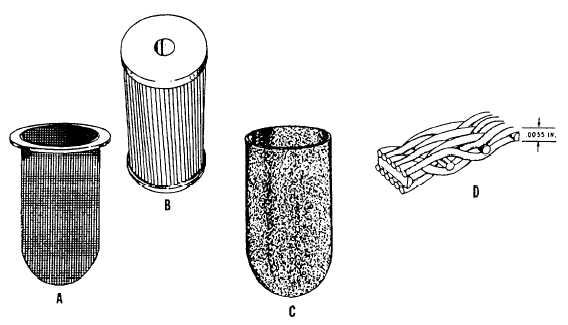container or component (view (A) of fig. 10-29). The size of wire mesh openings varies with the particular filter element, but normally a wire mesh filter element removes only the larger particles of contamination from the fluid.
A wire mesh filter element can be reused. It should be removed, cleaned, and reinstalled at scheduled intervals or when it becomes dirty. Replace it when it cannot be properly cleaned or is damaged.
MICRONIC FILTER. - Micronic, a term derived from the word micron, can be used to describe any filter element. Through usage, micronic has become associated with a specific filter with a filtering element made of a specially treated cellulose paper. The paper is formed in vertical convolutions (wrinkles) and is made in a cylindrical pattern. A spring in the hollow core of the element holds the element in shape (view (B) of fig. 10-29).
Micron is a unit of measurement used to express the degree of filtration. A micron equals one millionth of a meter or 0.0000394 inch. For comparison value, con- sider that the normal lower level of visibility to the naked eye is about 40 microns. (A grain of table salt measures about 100 microns; the thickness of a human hair is about 70 microns; and a grain of talcum powder is about 10 microns.)
When it is used in CESE hydraulic systems, the micronic element normally prevents the passage of solids of 10 microns or greater in size. The micronic filter element is disposable.
POROUS METAL FTLTER. - Use porous metal filter elements in hydraulic systems in which high pressures exist and/or a high degree of filtration is required. The two porous metal elements discussed - sintered bronze and stainless steel - are capable of filtering out solid particles and 5 and 15 microns, respectively.
Porous metal filter elements are reusable. When the filter element becomes contaminated, it is removed from the system, cleaned, tested, and reinstalled for further use. The number of times a filter element can be cleaned and reused depends on the particular type of element and the system in which it is used. Likewise, if the filter element is damaged in any way or does not meet test requirements, it must be discarded.
Sintered Bronze Filter. - The sintered bronze element consists of minute bronze balls joined together as one solid piece while still remaining porous (view(C) of fig. 10-29).
Stainless Steel Filter. - Stainless steel filter elements are used in many of the Navy's most modern hydraulic systems. This element is similar in

Figure 10-29.-Some typical types of hydraulic screens and filters.
Continue Reading